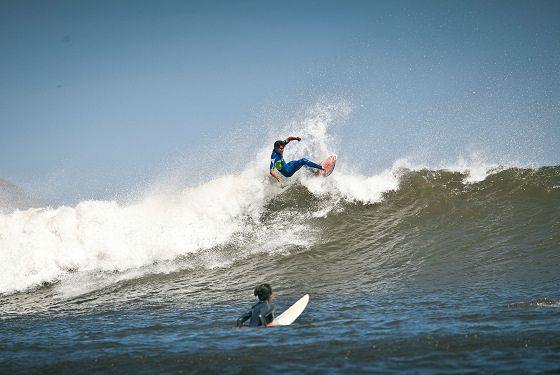Surf’s Up! Ride the World’s Longest Wave in Chicama, Peru
Peru is not usually what comes to mind when one thinks of kick-ass surfing trips. That is, unless you’re an actual surfing fanatic. Forget Hawaii, California and even Australia: if it’s superlative surfing you’re after – minus the bling, the crowds, and the expense of the world’s most popular surfing destination – pack that surfboard or paddle board depending on what you like and head to Peru.
Here, you’ll find not just the longest surfable wave in the world, in unassuming Chicama, but an entire surfing culture that’s kept itself hidden from the rest of the (commercially exploited) surfing world.
Northern Peru – the quiet achiever of the surfing world
Regarded by many as the ‘serious traveller’s destination’, Northern Peru has more aces up its sleeve than arguably many other South American countries combined. Just like no-bullshit mountaineers head to the Cordillera Blanca in the north of the country to get their climbing-fix, whilst show-offs head to the Himalayas, so too do serious surfers.
If they wish to spend a few blissful weeks just enjoying exceptional surfing – intertwined with amazing ceviche devouring – this is where they come.
Why is Peru’s coast such a treat?

Because in a relatively short stretch of coastline, only 1,000 km from Lima to the Ecuadorian border, you’ll find endless stretches of surfing beaches with waves suitable for all levels, two of which have set world records. Mancora is home to the world’s largest left-hand point break, and Chicama, just a short distance north of Trujillo, boasts the world’s longest wave. At 4km in length, the Chicama wave is ‘an astonishing feat of Mother Nature’.
All the beaches here enjoy consistent offshore winds, making surfing ideal just about all year long.
Surfing culture is huge in this region of Peru but, and perhaps what is most astonishing, it’s somehow kept large commercialization at bay. This is where pro-surfers and the biggest names in the business come to enjoy their passion and unwind, away from gawkers, autograph-chasers and fuss.
Beaches and waves are uncrowded, local surfers not snobby or territorial, and travel here, in general, is hassle-free and affordable. With world-class waves such as these, many avid surfers are keen to keep this place a secret.

Chicama – the record breaker
To those who don’t share the surfing passion, the whole ordeal may seem more trouble than it’s worth. Usually, to reach a break, surfers must paddle out for what seems like an eternity: flat on their bellies, arms paddling wildly, battling waves, a sore back, stinging eyes and a most annoying crick in the neck. Then, when they finally reach the break, they excitedly stand up and surf. For just a few seconds. Then they must start all over again.
In Chicama, if they’re good, they could be ridin’ that wave for 5 whole minutes. In surfing terms, this equates to ‘happily ever after’. Never mind the half-hour walk needed to get back to their starting point!
As hard as it is to measure these things, Chicama is rated the longest wave in the world. To ride it, a domino effect must occur. The wave at Chicama is actually a collection of four sections, which need substantial southern swells to ‘combine’.
Although exceptional surfing is to be had here all year long – and certainly plenty even for the most pro of surfers – the best time to catch this phenomenal wave is between the months of May to September.
Peruvian pro surfer Cristobal de Col went down in the Guinness Book of records for his ride in Chicama, clocking up no less than 34 turns in just a single wave. Have a few minutes to spare? Be amazed and watch the video of his achievement right here.
So why is Peru, as a surfing destination, so unknown?
There are several reasons why Peru has remained very much off the high-profile surfing list. Those who head here for a few weeks every year, believe that the remoteness of some of the beaches, lack of major infrastructure and language barrier keep many surfer dudes (and dudettes) away.
For those willing to go to some effort, however, things couldn’t be more perfect. Head here in summer and you’ll see beaches filled with locals…and very few tourists. Surfing schools and shops operate for about 6 months of the year, offering tuition for just a few dollars an hour.
To top it all off, these guys are really good at what they do and many believe some of the world’s best surfers are hiding in Peruvian surfing schools.
Accommodation choices are plenty here too, from the luxe Chicama Surf Resort to cosy backpacker hostels that tend to kidnap surf-lovers for months (if not years) at a time.
Locals are friendly, the seafood divine and general atmosphere blissfully relaxing. Seriously, even if you don’t even know which end of the board goes first in a wave, you ought to check this place out when next in Peru. Watching the pros in action is eye-candy enough.
If you're interested in the surf, or any of the country's other delights, Chimu's Signature Peru itineraries will take you there with ease.

Talk to one of our experienced Destination Specialists to turn your Antarctic, Arctic and South American dream into a reality.
Contact us